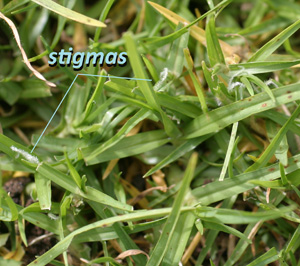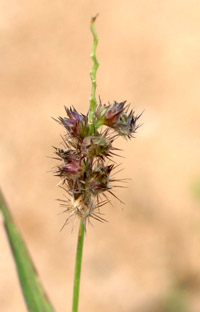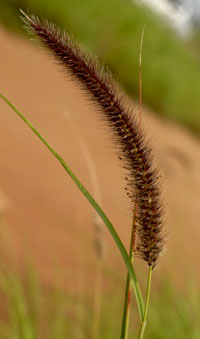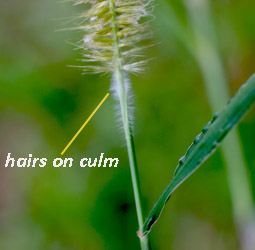|
|
|
[GENUS CENCHRUS]
|
|
|
|
|
46a
|
|

 Inflorescence (upon very close examination) is a few-spikelet spike enclosed in the uppermost leaf sheath, so only filaments and/or stigmas are exposed (see also Figure 20C). { Grass forming dense growth from rhizomes and stolens in dry to mesic open areas (see Fig. 9F below). Popular lawn and pasture forage at higher elevations on Maui and Hawai‘i Islands, but occurring on all the main islands (Fig. 9B). USDA noxious weed. Kikuyu grass [HAW - NAT] Inflorescence (upon very close examination) is a few-spikelet spike enclosed in the uppermost leaf sheath, so only filaments and/or stigmas are exposed (see also Figure 20C). { Grass forming dense growth from rhizomes and stolens in dry to mesic open areas (see Fig. 9F below). Popular lawn and pasture forage at higher elevations on Maui and Hawai‘i Islands, but occurring on all the main islands (Fig. 9B). USDA noxious weed. Kikuyu grass [HAW - NAT]Cenchrus clandestinus (Hochst. ex Choiv.) Morrone
|
|
|
46b
|
|
Inflorescence not mostly hidden within a leaf sheath, but of multiple spikelets carried above the leaves and terminal on the culm. Plants clumping .. .
|
|
[47] |
|
~~~~ ~~~~~~~~~~~~~~~~~~~~~~~~~
|
|
47a
|
(46) |
Plant forming a large clump with pink to deep purple or reddish bronze leaves .. .
|
|
[58] |
|
47b
|
|
Color of leaves mostly or entirely green .. .
|
|
[48] |
|
~~~~ ~~~~~~~~~~~~~~~~~~~~~~~~~
|
|
48a
|
( 45) & (47) 45) & (47) |
 Spikelet bristles soft, antrorsely scabrous (having tiny spine-like projections that point upward); if burr-like and attaching readily to clothing, NOT sharp and poking into skin .. . Spikelet bristles soft, antrorsely scabrous (having tiny spine-like projections that point upward); if burr-like and attaching readily to clothing, NOT sharp and poking into skin .. .
|
|
[52] |
|
48b
|
|
Spikelet bristles hard and sharp, retrorsely scabrous (having tiny spine-like projections that point downward), and forming a rings of spines surrounding spikelet. A bur sharp to the touch .. .
|
|
[49] |
|
~~~~ ~~~~~~~~~~~~~~~~~~~~~~~~~
|
|
49a
|
(48) |
 Spines on burs in two groups, the inner ones flattened, the outer small and rounded (terete) .. . Spines on burs in two groups, the inner ones flattened, the outer small and rounded (terete) .. .
|
|
[50] |
|
49b
|
|
Burs with spines in a single group or series .. .
|
|
[51] |
|
~~~~ ~~~~~~~~~~~~~~~~~~~~~~~~~
[NOTE: THREE CHOICES HERE]
|
|
50a
|
(49) |
 Bur 4-7 mm (<1/3 in) long; spines connate (melded together into a cup) surrounding spikelet upwards to at least half the length; bur more or less globose. { Small, bunching grass typically found in drier areas, often near the ocean shore (Fig. 9C). Common sandbur, ‘ume‘alu, mau‘u kukū [HAW - NAT] [GUM - NAT] [FACU]
Bur 4-7 mm (<1/3 in) long; spines connate (melded together into a cup) surrounding spikelet upwards to at least half the length; bur more or less globose. { Small, bunching grass typically found in drier areas, often near the ocean shore (Fig. 9C). Common sandbur, ‘ume‘alu, mau‘u kukū [HAW - NAT] [GUM - NAT] [FACU]
Figure 9C. Inflorescence of Cenchrus echinatus with burs (spikelets) shedding from the zigzag rachis.
|
|
|
50b
|
|
Similar to above (C. echinatus) but burs smaller, more delicate, and more crowded on longer and more numerous spike-like racemes. { Distribution similar to C. echinatus. Bur-grass [GUM - NAT] Cenchrus brownii R. &. S.
|
|
50c
|
|
Bur 8-18 mm (0.3-0.7 in) long; spines connate (melded together in a flared ring) only around base of spikelet with numerous smaller bristles above and below; bur more spindle-shaped. { Medium bunching grass, very rare, occurring typically on sand and dry, rocky ridges. Kāmanomano [HAW - END]Cenchrus agrimonioides Trin.
|
|
|
~~~~ ~~~~~~~~~~~~~~~~~~~~~~~~~
|
|
51a
|
(49) |
Burs 5–7 mm long (< 1/3 in), scabrous, the spines grooved. [HAW - NAT]
|
|
51b
|
|
Burs >1 cm (3/8 in) long and conspicuously hairy; spines not grooved. [HAW - NAT]
|
|
|
~~~~ ~~~~~~~~~~~~~~~~~~~~~~~~~
|
|
52a
|
(49) |
Most bristles conspicuously ciliate.. .
| |
[53]
|
|
52b
|
|
Bristles glabrous, scabrous, or with very sparse hairs .. .
| |
[57]
|
|
~~~~ ~~~~~~~~~~~~~~~~~~~~~~~~~
|
|
53a
|
(52) |
 Bristles detaching from the rachis with the spikelet at maturity, forming a soft bur that catches on clothing. Inner bristles ciliate (plume-like). { Color when fresh a shade of red or purple. Extremely common, medium-size, bunching grass in lowland dry areas in Hawai‘i (the dominant grass on leeward slopes)(Fig 9D). Buffelgrass [HAW - NAT]
Bristles detaching from the rachis with the spikelet at maturity, forming a soft bur that catches on clothing. Inner bristles ciliate (plume-like). { Color when fresh a shade of red or purple. Extremely common, medium-size, bunching grass in lowland dry areas in Hawai‘i (the dominant grass on leeward slopes)(Fig 9D). Buffelgrass [HAW - NAT]
Figure 9D. Newly developing inflorescence of buffelgrass.
|
|
|
53b
|
|
Not forming a bur that catches on fabric. Bristles glabrous or antorsely scabrous or plumose (feather-like) .. .
|
|
[54]
|
|
~~~~ ~~~~~~~~~~~~~~~~~~~~~~~~~
|
|
54a
|
(53) |
Medium size grass forming dense bunches of tough, narrow appearing (because leaf blades are rolled around a thick midrib) leaves. Cylindrical, pink to purple panicles, 3 to 12 in (6 - 30 cm) long. { Forming distinct clumps on dry, open landscapes; especially prominent covering vast areas of lava flows in Kona (Island of Hawai‘i) (Fig. 9A). HDA Noxious weed. Fountain grass [HAW - NAT] [GUM - NAT]Cenchrus setaceus (Forssk.) Morrone
|
|
|
54b
|
|
Small to large grasses with leaf blades not appearing wiry (up to 1.5 in or 4 cm across). Foxtail panicle may be purplish, but more typically yellow .. .
|
|
[55] |
|
~~~~ ~~~~~~~~~~~~~~~~~~~~~~~~~
|
|
55a
|
(54) |
 Perennial clumping grass. Culm below panicle with short to long hairs; rachis cylindrical or ribbed. Inflorescence up to 1 1/8 in (3 cm) in diameter. One bristle on each spikelet longer and stouter than all the others. Leaves glabrous or with long hairs at margins near blade base; ligule a thin membrane topped with tight packed hairs, to 3x length of membrane. { A large to very large, tufted grass found in wet areas, often close to streams; very common in upcountry Maui (Fig. 9E; see also couplet [58]). Elephant grass, Napier grass [HAW - NAT] [GUM - NAT]
Perennial clumping grass. Culm below panicle with short to long hairs; rachis cylindrical or ribbed. Inflorescence up to 1 1/8 in (3 cm) in diameter. One bristle on each spikelet longer and stouter than all the others. Leaves glabrous or with long hairs at margins near blade base; ligule a thin membrane topped with tight packed hairs, to 3x length of membrane. { A large to very large, tufted grass found in wet areas, often close to streams; very common in upcountry Maui (Fig. 9E; see also couplet [58]). Elephant grass, Napier grass [HAW - NAT] [GUM - NAT] Cenchrus purpureus (Schumach.) Morrone
|
|
|
55b
|
|
Culm below panicle with a few short or no hairs; rachis angular. Bristles generally straight; inner bristles of each spikelet all roughly the same size and plumose at base, without groove; densely ciliate, cilia generally obscuring spikelets. Spikelets 3.5 to 4 mm long. { Inflorescence up to 3/8 in (1 cm) in diameter. Typically medium or taller grass in dry, exposed areas; common on Guam. USDA noxious weed. Feathery pennisetum [HAW - NAT], Mission grass, sakate [GUM - IND/NAT]
|
|
On to
[56] |
|
~~~~ ~~~~~~~~~~~~~~~~~~~~~~~~~
|
|
56a
|
(55) |
Inflorescence expanded and crowded with viviparus spikelets: plantlets developing on inflorescence (pseudo-vivipary) { Rare. For a recent article with photos, see S. Bhowmik & Datta (2014). [GUM - IND]Cenchrus setosus (as polystachios) f. viviparus Fosb. & Sachet
|
|
56b
|
|
Inflorescence normal, about 3/8 in (1 cm) in diameter: spikelets not pseudo-viviparous. { Very common on Guam. [HAW - NAT] [GUM - NAT]Cenchrus setosus f. setosus Sw.
|
|
~~~~ ~~~~~~~~~~~~~~~~~~~~~~~~~
|
|
57a
|
(49) |
Annual. Bristles under 1 cm (< 0.4 in) long, persisting. { Rare, from bird seed or use in hydromulch (waif population) (see also couplet [58]). [HAW-NAT] Cenchrus americanus (L.) Marrone
|
|
|
|
|
57b
|
|
Perennial. Bristles greater than 1 cm (0.4) long, typically brownish purple in color, but deciduous after spikelets fall. Culm scabrous or minutely pubescent. [HAW-NAT]Cenchrus complanatus (Nees) Morrone
|
|
|
|
~~~~ ~~~~~~~~~~~~~~~~~~~~~~~~~
[NOTE: THREE CHOICES HERE]
|
|
58a
|
(47) |
Plant eventally growing to a cane up to 10 feet (3 m) in height. Inflorescence a purplish foxtail. Leaves greater than 20 cm (about 1 in wide). All bristles scabrous. { Burgundy fountain grass, burgundy giant [HAW - ORN] Cenchrus elegans (Hassk.) Veldk.
| |
|
|
|
58b
|
|
Inflorescence a purplish foxtail. Leaves 10 cm or less in width. At least one inner bristle plumose { [HAW - ORN]
| |
|
|
|
58c
|
|
Inflorescence culms produced are sterile (fail to produce seeds). ( Large, clumping perennial resembling elephant grass with purple leaves; grown for forage. Bana grass [HAW ORN] Cenchrus americanus x purpureus
|